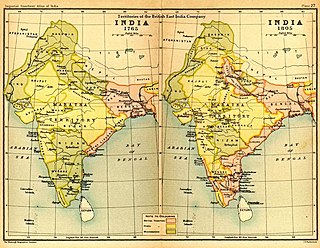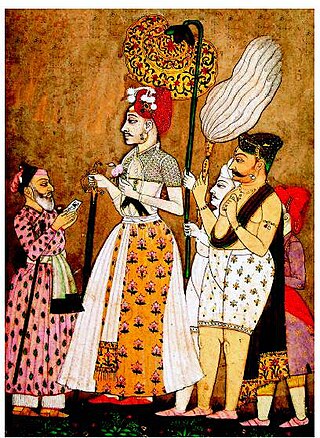Related Research Articles

The Third Battle of Panipat took place on 14 January 1761 between the Maratha Empire and the invading army of the Durrani Empire. The battle took place in and around the city of Panipat, approximately 97 kilometres (60 mi) north of Delhi. The Afghans were supported by four key allies in India: the Pashtun Rohillas under the command of Najib ad-Dawlah, the Baloch Khanate of Kalat, and the Oudh State under Shuja-ud-Daula as well as elements of the declining Mughal Empire. The Maratha army was led by Sadashivrao Bhau, who was third-highest authority of the Maratha Empire after the Chhatrapati and the Peshwa. The bulk of the Maratha army was stationed in the Deccan Plateau with the Peshwa.
The Scindia dynasty is a Hindu Maratha dynasty of maratha origin that ruled the erstwhile State of Gwalior. It had the Patil-ship of Kumberkerrab in Wai. It was founded by Ranoji Scindia, who started as a personal servant of the Peshwa Bajirao I. Ranoji and his descendents along with their rivals the Holkars, played a leading role during the Maratha ascendency in North india during the 18th century. The Gwalior state was a princely state under the British Raj during the 19th and the 20th centuries. After India's independence in 1947, several members of the Scindia family went on to enter Indian politics.

Balaji Bajirao, also known as Nana Saheb I, was the 8th Peshwa of the Maratha Confederacy in India. He was appointed as Peshwa in 1740 upon the death of his illustrious father, the Peshwa Bajirao I.

Suraj Mal was a Jat ruler of Bharatpur in present-day state of Rajasthan. Under him, the Jat rule covered the present-day districts of Agra, Aligarh, Bharatpur, Dholpur, Etawa, Hathras, Mainpuri, Mathura, and Rohtak.

Raghunathrao Bhat also known as Ragho Ballal or Ragho Bharari was the 11th Peshwa of the Maratha Empire for a brief period from 1773 to 1774. He was known among the Hindus for his extremely successful North-western campaign of 1757-58 and for his works to liberate the Hindu holy places of Kashi and Ayodhya.

Mahadaji Shinde, later known as Mahadji Scindia or Madhava Rao Sindhia, was a Maratha statesman and ruler of Ujjain in Central India. He was the fifth and the youngest son of Ranoji Rao Scindia, the founder of the Scindia dynasty.

Malhar Rao Holkar was a noble subedar of the Maratha Empire, in present-day India. He was one of the early officers along with Ranoji Scindia to help spread the Maratha rule to northern states and was given the estate of Indore to rule by the Peshwas, during the reign of the Maratha emperor Shahu I. He was founder of the Holkar dynasty that ruled Malwa.

Gwalior state was a semi-autonomous Maratha state. It was centred in modern-day Madhya Pradesh, arising due to the rise of the Maratha Empire and fragmentation of the Mughal Empire.

Shrimant Daulat Rao Shinde was the Maharaja (ruler) of Gwalior state in central India from 1794 until his death in 1827. His reign coincided with struggles for supremacy within the Maratha Empire, and wars with the expanding East India Company. Daulatrao played a significant role in the Second and Third Anglo-Maratha wars.

Najib ad-Dawlah, also known as Najib Khan Yousafzai, was a Rohilla Yousafzai Afghan who earlier served as a Mughal serviceman but later deserted the cause of the Mughals and joined Ahmed Shah Abdali in 1757 in his attack on Delhi. He was also a House chief of Rohilkhand, and in the 1740s founded the city of Najibabad in Bijnor district, India. He was instrumental in winning the Third Battle of Panipat.

Jawahar Singh was a Jat ruler of the Bharatpur State. He succeeded to the throne when his father Suraj Mal died in 1763.

The Maratha Conquests were a series of conquests in the Indian subcontinent which led to the building of the Maratha Empire. These conquests were started by Shivaji in 1659, from the victory at the Battle of Pratapgad against Bijapur. The expansion of the empire was limited and interrupted by the Mughal conquests of south India by Mughal emperor Aurangzeb. Marathas were forced to defend their territories against the overwhelmingly strong Mughal army in the 27 years long Deccan wars. They were able to defend their territories and gain an upper hand over Mughals in the sustained conflict.

Sadashivrao Bhau Peshwa was son of Chimaji Appa and Rakhmabai and the nephew of Baji Rao I. He was a finance minister during the reign of Maratha emperor Chhatrapati Rajaram II. He led the Maratha army at the Third Battle of Panipat.
Jayappaji Rao Shinde also known as Jayappa Dadasahib, was a Maratha general. He ruled Gwalior State in northern India from 1745 to 1755, succeeding his father Ranoji Rao Scindia who had founded it.

Vishwasrao Bhat was the eldest son of Peshwa Balaji Baji Rao of the Maratha Empire and also was the heir to the title of Peshwa.
The Maratha conquest of Northwest India occurred between 1757 and 1759, when the Maratha Empire captured the northwestern parts of the Indian subcontinent from the Durrani Empire. It had long-lasting effects upon the future geopolitics of the Indian subcontinent.

The Great Maratha is an Indian historical drama television series directed by Sanjay Khan and produced by Numero Uno International Limited. The drama aired on DD National. The series is based on the life of Mahadaji Shinde. The show comprised 47 episodes. The music was composed by Mohammed Zahur Khayyam.

Dattaji Rao Scindia, also known as Dattaji Rao Shinde, was the second son of Ranoji Rao Shinde and Maina Bai, alias Nimba Bai. His elder brother was Jayappaji Rao Shinde and his younger brother was Jyotiba.

Panipat is a 2019 Indian Hindi-language epic war drama film directed by Ashutosh Gowarikar. Starring Arjun Kapoor, Sanjay Dutt and Kriti Sanon, it depicts the events that took place during the Third Battle of Panipat. The film was theatrically released in India on 6 December 2019. The film was a box office failure.
The Capture of Delhi was a battle in 1771 when the forces of the Maratha Empire led by Mahadaji Shinde captured Delhi along with the Red Fort, and giving Mughal Emperor Shah Alam II the throne back with treaty. The Marathas captured Delhi from Najib Khan who wads put in charge by the Afghans. With this battle Marathas regained their lost supremacy in North India after the Third Battle of Panipat and conquered much of the lost territories which they lost after the Third Battle of Panipat.
References
- ↑ Cahoon, Ben. "Indian Princely States A-J". www.worldstatesmen.org. Retrieved 1 April 2018.
- ↑ Abhas Verma, "Third Battle of Panipat" , Bharatiya Kala Prakashan, ISBN 9788180903397